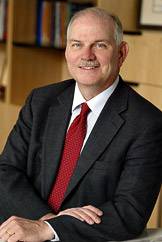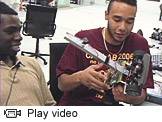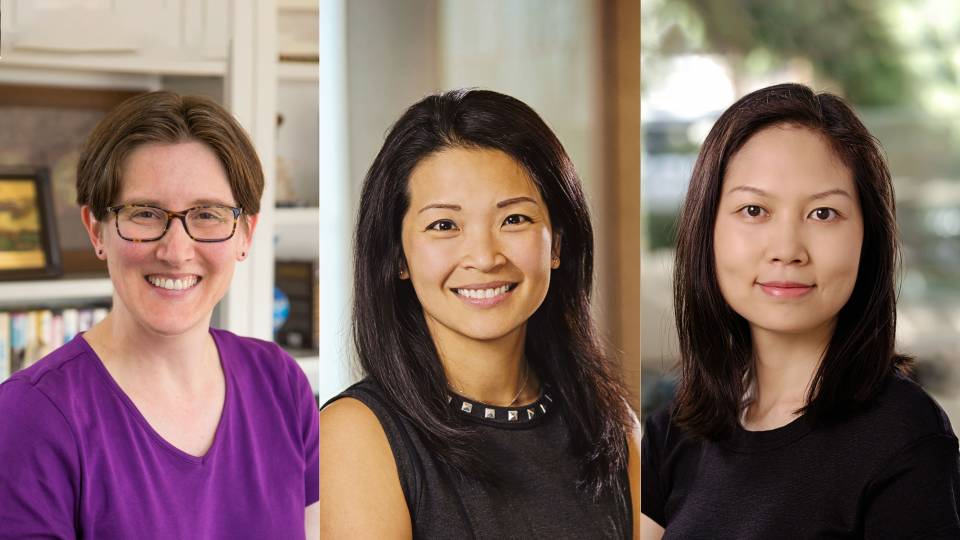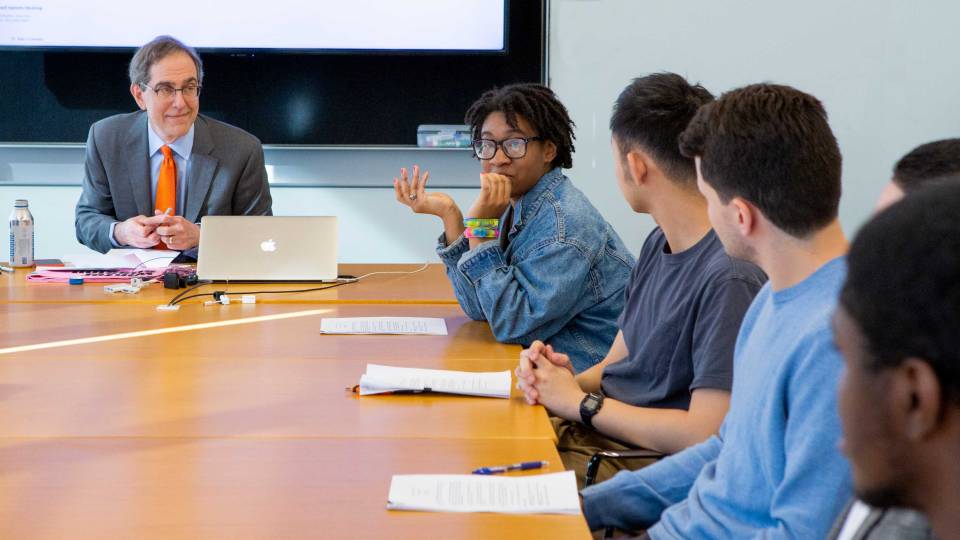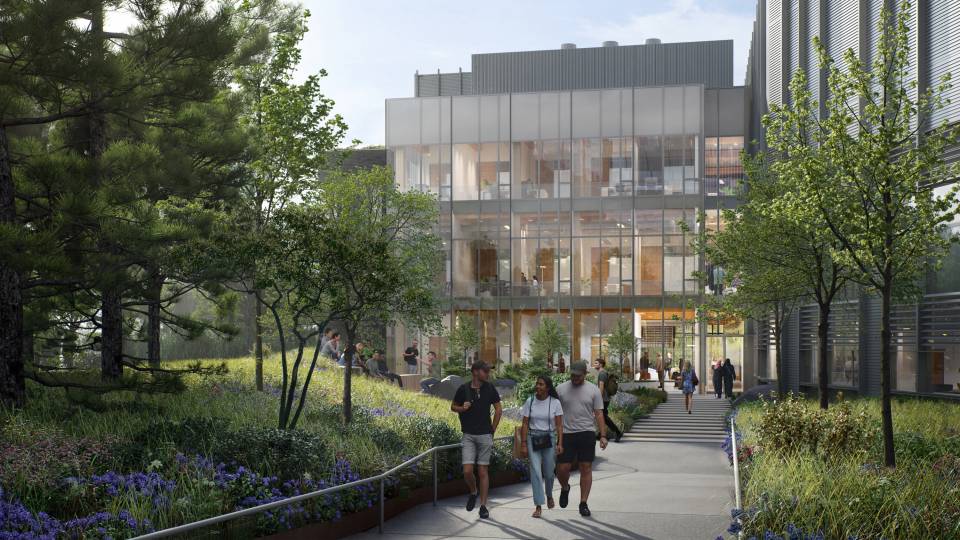From the Feb. 11, 2008, Princeton Weekly Bulletin
In many ways, H. Vincent Poor, a 1977 graduate alumnus who became dean of the School of Engineering and Applied Science in June 2006, epitomizes Princeton's tradition of the teacher-scholar.
A distinguished researcher in the field of electrical engineering, Poor for several years taught a course on the wireless revolution, which was one of the most popular undergraduate classes on campus and was heralded as a model for teaching technology in a political, economic and social context. In 2002, Poor was awarded a National Science Foundation Director's Award for Distinguished Teaching Scholars. Shortly before becoming dean, Poor launched Princeton's Center for Innovation in Engineering Education, which embraces an entrepreneurial, risk-taking approach to teaching engineers and non-engineers.
As the Michael Henry Strater University Professor of Electrical Engineering, Poor leads a robust 20-member research group, and he continues to collaborate with industry. In the past two years, he has received six U. S. patents on various aspects of wireless communication technology, five of which have been assigned to industry. Poor's most recent book, which will be published this year by Cambridge University Press, addresses "statistical change detection" — a fundamental problem that arises not only in engineering but also in the natural and social sciences.
These accomplishments inform Poor's leadership as he guides the engineering school's current growth, which involves major efforts to develop more inventive teaching methods and to expand interdisciplinary research initiatives to better serve society. The school enrolls about 20 percent of the University's undergraduates and about 25 percent of its graduate students. As dean, Poor oversees six engineering departments: civil and environmental, chemical, electrical, mechanical and aerospace, and operations research and financial engineering, as well as computer science.
In the following interview, Poor talks about the School of Engineering, reflecting on its past and contemplating its future.
When you were invited to speak recently at Harvard's launch of its engineering school, you talked about the role of engineering in the context of a liberal arts university. What is that role?
The primary role of engineering as a discipline is to use scientific knowledge to do useful things for society. So in academia, engineering serves as a bridge between the natural sciences on one hand and the humanities and the social sciences on the other. Engineers are, of course, involved very closely with natural scientists in seeking new scientific knowledge. But, engineers also work closely with humanists and social scientists in examining the implications of technology. At a liberal arts university, engineering plays a central role not only in research but also in teaching. It is our responsibility as engineering educators to make sure that all of our students, whether they are majoring in engineering or not, are technologically literate.
How do you view the progress of Princeton's efforts to strengthen that role?
I would point to our Center for Innovation in Engineering Education as a prime example of our progress in strengthening links between engineering and the broader world. In its short lifetime, the center has made great strides, introducing new lecture series as well as new courses, some of which are interdisciplinary within engineering and others that reach broadly across campus. The center's EPICS (Engineering Projects in Community Service) program brings together engineers and non-engineers to create engineering solutions for specific community problems. You will be hearing about other ambitious initiatives in the near future. Our goal is always to provide education of the highest quality both within the School of Engineering and to students outside of engineering.
With engineering as a major priority in the University's newly launched fundraising campaign, what are the key goals for the school's continued growth?
Our priorities cover four major areas of societal need: energy, environment, health and security. We plan targeted growth in these four areas, creating new faculty positions and supporting those new positions with a commensurate growth in student body and new research facilities. Many of the new faculty members will have joint appointments with other units on campus — the Woodrow Wilson School of Public and International Affairs, the Princeton Environmental Institute, the School of Architecture, molecular biology, genomics, neuroscience, chemistry and others.
Of course, energy and the environment are not new areas for us. We have been collaborating for years with the Princeton Environmental Institute and the Woodrow Wilson School — most notably in connection with the Carbon Mitigation Initiative. But we are already experiencing significant growth in this area, and I expect that this will continue dramatically in the coming years — in every area of engineering. Major technological innovations are needed if we want biofuels and solar energy to become practical alternatives to fossil fuels. Princeton engineering is increasingly involved in clean technology in general — for example, in green buildings and green information technology. Energy and environment also pose significant challenges in financial engineering, such as carbon trading or the effects of biofuel production on commodity prices, areas in which we can leverage our partnership with economics through the Bendheim Center for Finance.
The School of Engineering already has significant research programs related to human health, from the development of nanoparticles for drug delivery to innovative approaches for treating diabetes. But we have even bolder ambitions. As President Shirley Tilghman has often noted, biology is experiencing a revolutionary shift, one that calls for multidisciplinary collaboration. At the vanguard of this shift are unrivaled researchers at Princeton in the Department of Molecular Biology, the Lewis-Sigler Institute for Integrative Genomics and the Princeton Neuroscience Institute. While we have substantial collaborations now with our colleagues in these life sciences, by deepening, expanding and leveraging these collaborations the School of Engineering can become a world-class center for biological engineering.
We also plan to build on our broad strengths in the field of security. This means both traditional aspects of security, which you might think of in terms of national or homeland security. But it also means secure information technology — for example, security and privacy on the Internet and in wireless communications. Our newly launched Center for Information Technology Policy addresses questions such as the security of electronic voting or the security of electronic medical records. Another aspect of security is economic and financial security. Engineering expertise can be brought to bear on general problems of decision-making in the face of uncertainty. Tsunamis, earthquakes, terrorist attacks — these events are going to happen. But society has to plan and to go forward without being paralyzed by them. Engineering plays a key role in the mitigation of risk associated with such events.
Currently more than half of non-engineering students at Princeton take an engineering course during their academic career. What are the challenges of teaching technology to humanities students?
Motivating students to learn technological subjects is not hard since most of today's students are very curious about technology. Also, because the impact of technology is so pervasive — ranging from very basic human needs such as water and shelter, to relatively more abstract things such as information and energy — it touches on the interests of most students. So the difficulty tends to be primarily pedagogical, in that engineering is typically taught in a hierarchical fashion with courses being built on a series of prerequisites. One of our biggest challenges in teaching to non-majors is to unthink that mode of teaching. Essentially, you have to unlearn all the things you know about a subject, to go back to the point where you did not know them, and then build a course on a base of common knowledge. We teach engineers how to create technology; with non-engineers, the focus instead is on the social, political and economic dimensions of technology. As a teacher, putting all of these facets of technology together is challenging, but also very rewarding.
What were the big challenges that Princeton's engineering school faced when you received your graduate degree here 30 years ago? Are they fundamentally different from those you face today as dean?
There are many commonalities between then and now. As a graduate student, I enjoyed substantial intellectual freedom — the ability to explore whatever interesting problems appealed to me, to learn things in-depth, to branch out to other fields like physics or mathematics without the daily pressure of having to meet deadlines for a research sponsor.
On the other hand, I would say that engineering at that time was much more inward-looking and less engaged with the outside world, or with the rest of campus than today. Even physically, there was a geographical disconnect with the rest of campus. Thirty years ago there was no Friend Center, no Bowen Hall, no Wallace Hall. It would have been rare to see students from the humanities or social sciences in the engineering neighborhood of campus. Today we have become much more thoroughly integrated with the rest of campus — not only physically but intellectually as well. We have some surprising interdisciplinary connections — between electrical engineering and philosophy, for example, or between computer science and music. Our students are internationally engaged as well. The Princeton chapter of Engineers Without Borders does important work abroad, in places like Guatemala and Ethiopia. We also work more closely with industry today. So there are many differences, although our core values of quality and an emphasis on fundamentals are still constant.
What do you want Princeton's engineering neighborhood to be like 30 years from now?
My hope is that undergraduates and graduate students arriving here in 2038 will experience the same intellectual freedom that has always been a hallmark of the Princeton engineering education. But I also hope that engineering's boundaries — both physical and intellectual — will have expanded even beyond where they are today.
Princeton has a large engineering school relative to the size of the University, and this gives us an opportunity — and an obligation — to help define what will constitute a liberal arts education in the future. In 30 years, I expect that there will be a seamless integration between engineering and the rest of campus. Technological literacy will play the same role that, say, economics does today in the sense that it will be a natural part of undergraduate education.
If we are able to make wise investments in the near term I think we will see an explosive growth at Princeton in biological engineering, in fields related to energy, environment and security, and in interfaces between engineering and fields like neuroscience. I expect that students will become even more involved with the Woodrow Wilson School, because virtually all technologies have important policy implications, and of course many key policy issues, such as the response to climate change, have major technological components. Our international experience and presence will continue to expand. Every Princeton engineer will be a world citizen.
In terms of physical growth, Princeton is currently constructing a striking new building that will house our Department of Operations Research and Financial Engineering and the Center for Information Technology Policy. That building will complete a new quadrangle in the engineering neighborhood, anchored with the Computer Science Building, the Friend Center and Mudd Library. With this new building and the ambitious expansion of laboratory space under way, our current neighborhood will be completely built-out within the next five to 10 years. My expectation is that in the coming three decades, engineering's building opportunities will be in the science neighborhood of campus — as joint enterprises with other disciplines.
A new venture this year is Princeton's Grand Challenges Initiative. How did that partnership develop, and what is engineering's role?
The Grand Challenges Initiative is a joint effort among the School of Engineering, the Princeton Environmental Institute and the Woodrow Wilson School. This grew largely out of our existing partnership in the Carbon Mitigation Initiative, which I mentioned earlier and which is a large joint research program funded by BP and Ford that strives to address some of the underlying scientific, technological and political issues relating to climate change.
Grand Challenges expands on the general idea of taking an interdisciplinary approach to addressing major societal issues — issues like energy and climate, global health and poverty in Africa. These three are particularly important examples of issues that have significant science, technology and policy components. They also are areas in which we can integrate research with teaching at all academic levels, from freshman seminars to postdoctoral projects. I should point out that the range of disciplines brought to bear on the problems identified in the Grand Challenges Initiative is very broad, potentially encompassing all of the engineering disciplines, the natural and social sciences, and the humanities. So the idea is to bring as much intellectual firepower to bear on these problems as is possible.
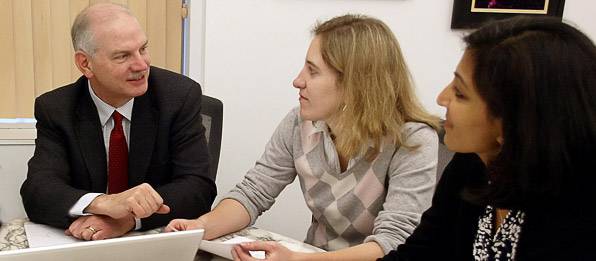
While serving as dean, Poor continues to run his 20-member research group in electrical engineering. Here, from left, he meets with graduate student Sharon Betz and postdoctoral researcher Lalitha Sankar. "Since engineering is primarily about innovation, I do not think I could be fully engaged as dean in a place like Princeton without continuing my research," Poor said.
You are juggling the everyday responsibilities of the dean's office, yet you continue to make your research a priority. How is the research going?
Since engineering is primarily about innovation, I do not think I could be fully engaged as dean in a place like Princeton without continuing my research. Engineering is a rapidly changing field; you have to stay at the top of your game at all times, or you can fall hopelessly behind. I feel that my research is going well — I have a rather large group of outstanding graduate students, postdocs and visitors, and we are involved in some exciting things, mainly in the field of wireless communications. Being dean informs my research in the sense that I have a broad view of what is going on in the engineering school and in the University at large. So I see areas where the methodology I use in my own research might have a role in other disciplines.
You have been having regular dinners with freshmen this year. What is the most surprising thing you have learned from your conversations with members of the class of '11?
The thing that always amazes me about freshmen is their insight, at such a young age, into what they want to do with their lives. Their breadth and passion and energy give me great hope for the future.
